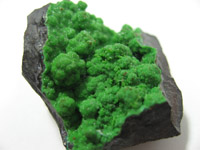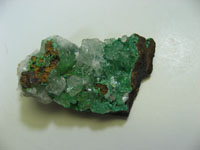![]()
Conichalcite is a relatively common arsenate mineral related to duftite. Conichalcite was first discovered in 1849 at a location in Andalusia, Spain. The name conichalcite is credited to August Breithaupt and Carl Julius Fritzsche in 1849 from the Greek κουία for "konis" (powder) and χαλκος for "chalkos" (copper) in allusion to its composition and appearance of the mineral at times. Notable occurrences of conichalcite include Juab County, Utah; Lincoln and Lyon counties of Nevada and Bisbee, Arizona, in the United States; Durango, Mexico; Collahuasi, Tarapaca, Chile; Calstock, Cornwall and Caldbeck Fells, Cumbria, England; Andalusia, Spain; and Tsumeb, Namibia.
![]()
Within the metaphysical realm of minerals, conichalcite unites a believer's heart with their intellect to enhance communication and personal power in a loving manner. It stimulates their intuition, imagination and adaptability. It helps a believer to realize the boundlessness of their abilities.
Please note that MIROFOSS does not suggest in any way that minerals should be used in place of proper medical and psychological care. This information is provided here as a reference only.
![]() Conichalcite is mostly used as a collectors mineral but is sometimes processed as a minor source of the element Arsenic.
Conichalcite is mostly used as a collectors mineral but is sometimes processed as a minor source of the element Arsenic.
![]()
Conichalcite is a secondary mineral found in the oxidized zones of copper deposits.
![]()
Conichalcite is green, often botryoidal, and occurs in the oxidation zones of copper orebodies. Here groundwater enriched with oxygen reacts with copper sulfide and copper oxide to produce an array of minerals such as malachite, azurite and linarite. Conichalcite is often found encrusted on to limonitic rocks that have yellow to red colours. Conichalcite will also form a solid solution series with the mineral calciovolborthite. When these two minerals form a solid solution series, the two interchanging elements are arsenic and vanadium. Conichalcite is the arsenic rich end member of the series and calciovolborthite is the vanadium rich end member.
![]()
| Cleavage | None | |
| Colour(s) | Yellowish green, Emerald green | |
| Specific Gravity | 4.1 | |
| Diaphaneity | Subtranslucent | |
| Fracture | Brittle - Uneven - Very brittle fracture producing uneven fragments | |
| Mohs Hardness | 4.5 | |
| Luminescence | Non-fluorescent | |
| Lustre | Vitreous, greasy | |
| Streak | Light green | |
| Habit(s) | Fibrous to Massive to Reniform | |
| Radioactivity | Non-radioactive | |
| Magnetism | Non-magnetic |
![]()
The following health hazards should be noted when handling conichalcite:
 |
ENVIRONMENTAL HAZARD Conichalcite contains the element Arsenic which is known to cause long term environmental effects. |
 |
TOXIC Conichalcite contains the element Arsenic which is fatal if ingested. |
![]()
The following image shows the elemental breakdown of the mineral conichalcite along with the mineral crystal structure:
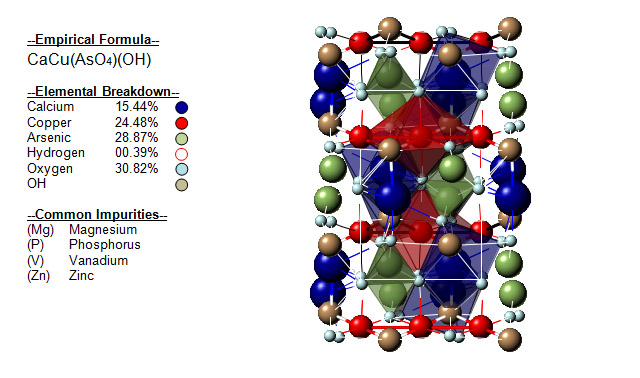
![]()
| Crystal System | Orthohombic |  |
| Class | Disphenoidal | |
| Axial Ratios | a : b : c = 0.7994 : 1 : 0.6297 | |
| Morphology | Typically radial fibrous aggregates, botyroidal to reniform crusts, massive | |
| Optical Data Type | Biaxial (+/-) | |
| Pleochroism (x) | Green | |
| Pleochroism (y) | Yellowish green | |
| Pleochroism (z) | Bluish green |  |
| RL Values | nα = 1.778 - 1.800 nβ = 1.795 - 1.831 nγ = 1.801 - 1.846 | |
| Max Birefringence | δ = 0.034-0.046 (See colour chart at right) | |
| Surface Relief | Very high | |
![]()
Conichalcite can be referenced in certain current and historical texts under the following two names:
The mineral conichalcite can be translated into the following select languages:
| Arabic | Bulgarian | Chinese (Sim) | 砷钙铜矿 | ||
| Croatian | Czech | Danish | |||
| Dutch | Esperanto | Estonian | |||
| Finnish | French | German | Konichalcit | ||
| Greek | Hebrew | Hungarian | |||
| Italian | Conicalcite | Japanese | コンニチャルチャイヅ | Korean | 컨니찰사읻 |
| Latin | Lithuanian | Norwegian | |||
| Persian | Polish | Staszycyt | Portuguese | ||
| Romanian | Russian | Конихальцит | Slovak | ||
| Spanish | Conichalcita | Swedish | Tagalog | ||
| Turkish | Ukrainian | коніхальціт | Vietnamese |
![]()
Conichalcite can be found in a few select locations around the world. The map below shows major documented concentrations of conichalcite:
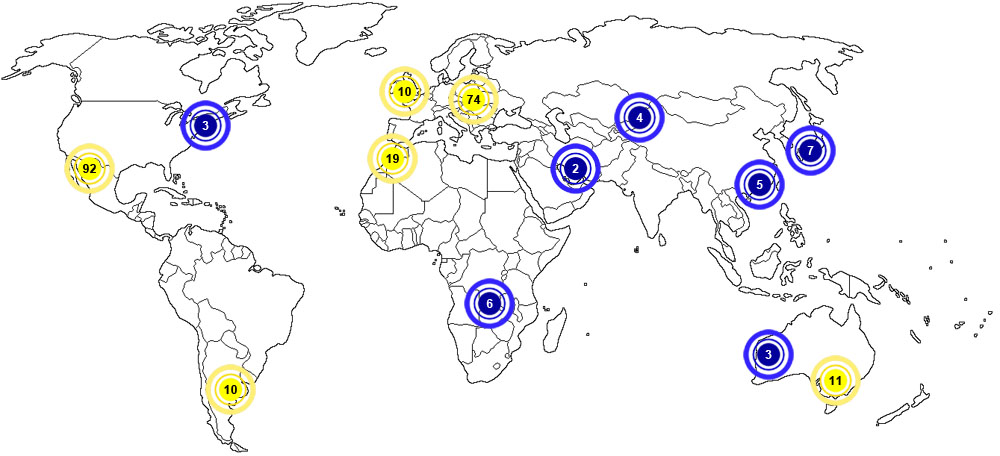

![]()
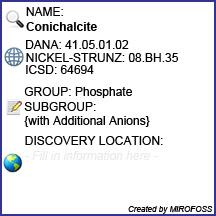 |
The MIROFOSS database offers free printable geological identification tags for personal and non-profit use. These tags can be used to properly identify mineral samples in your collection. -Click here- to download a full size jpeg image for a conichalcite identification tag; which can be printed on paper or used with a plastic laser printer. |
 |
What's this? What can I do with it? |
![]()
| Crystallography | Sakai, S., Yoshiasa, A., Sugiyama and Miyawaki, R. (2009): Crystal structure and chemistry of conichalcite, CaCu(AsO4)(OH). Journal of Mineralogical and Petrological Sciences, 104, 125-131. |
| Crystallography | T. Djordjević and U. Kolitsch (2008): Conichalcite revisited: Structural and chemical characterisation of a sample from the Maria Catalina mine, Copiapó Province, Chile. Poster, Annual Meeting of the DMG, Berlin, Germany, September 14-17, 2008; CD with abstracts, Abs. no. 331. |
| History | Reddy, B.J.; Frost, R.L.; Martens, W.N. (2005): Characterization of conichalcite by SEM, FTIR, Raman and electronic reflectance spectroscopy. Mineralogical Magazine 69, 155-168. |
| History | Anthony, J.W., Bideaux, R.A., Bladh, K.W., and Nichols, M.C. (2000) Handbook of Mineralogy, Volume IV. Arsenates, Phosphates, Vanadates. Mineral Data Publishing, Tucson, AZ, 680pp.: 125. |
| History | Palache, C., Berman, H., & Frondel, C. (1951), The System of Mineralogy of James Dwight Dana and Edward Salisbury Dana, Yale University 1837-1892, Volume II. John Wiley and Sons, Inc., New York, 7th edition, revised and enlarged, 1124 pp.: 806-809. |
| History | Canadian Mineralogist (1969): 7: 561-577. |
| Geographical Data | Mindat.org. Retrieved on 2012-06-18 |
| Physical Identification | Webmineral.com. Retrieved on 2012-06-18. |
| June 28, 2014 | The last time this page was updated |
| ©2018 MIROFOSS™ Foundation | |
 |
|

